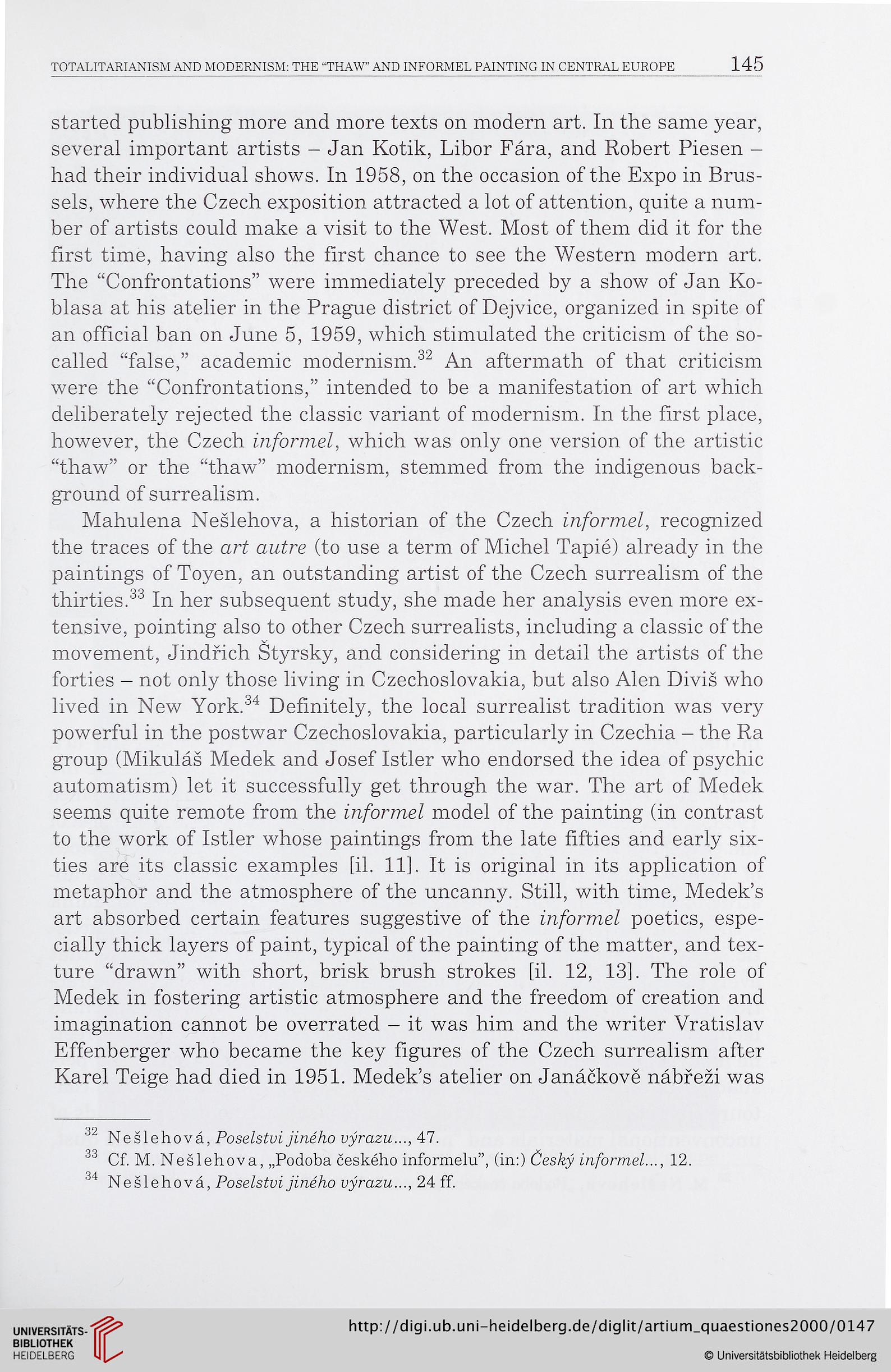TOTALITARIANISM AND MODERNISM: THE “THAW” AND INFORMEL PAINTING IN CENTRAL EUROPE
145
started publishing more and more texts on modem art. In the same year,
several important artists - Jan Kotik, Libor Fâra, and Robert Piesen -
had their individual shows. In 1958, on the occasion of the Expo in Brus-
sels, where the Czech exposition attracted a lot of attention, quite a num-
ber of artists could make a visit to the West. Most of them did it for the
fïrst time, having also the first chance to see the Western modem art.
The “Confrontations” were immediately preceded by a show of Jan Ko-
blasa at his atelier in the Prague district of Dejvice, organized in spite of
an official ban on June 5, 1959, which stimulated the criticism of the so-
called “false,” academie modernism.32 An aftermath of that criticism
were the “Confrontations,” intended to be a manifestation of art which
deliberately rejected the classic variant of modernism. In the first place,
however, the Czech informel, which was only one version of the artistic
“thaw” or the “thaw” modernism, stemmed from the indigenous back-
ground of surrealism.
Mahulena Neslehova, a historian of the Czech informel, recognized
the traces of the art autre (to use a term of Michel Tapié) already in the
paintings of Toyen, an outstanding artist of the Czech surrealism of the
thirties.33 In her subséquent study, she made her analysis even more ex-
tensive, pointing also to other Czech surrealists, including a classic of the
movement, Jindrich Styrsky, and considering in detail the artists of the
forties - not only those living in Czechoslovakia, but also Alen Divis who
lived in New York.34 Defïnitely, the local surrealist tradition was very
powerful in the postwar Czechoslovakia, particularly in Czechia - the Ra
group (Mikulâs Medek and Josef Istler who endorsed the idea of psychic
automatism) let it successfully get through the war. The art of Medek
seems quite remote from the informel model of the painting (in contrast
to the work of Istler whose paintings from the late fifties and early six-
ties are its classic examples [il. 111. It is original in its application of
metaphor and the atmosphère of the uncanny. Still, with time, Medek’s
art absorbed certain features suggestive of the informel poetics, espe-
cially thick layers of paint, typical of the painting of the matter, and tex-
ture “drawn” with short, brisk brush strokes [il. 12, 131. The rôle of
Medek in fostering artistic atmosphère and the freedom of création and
imagination cannot be overrated - it was him and the writer Vratislav
Effenberger who became the key figures of the Czech surrealism after
Karel Teige had died in 1951. Medek’s atelier on Janâckovë nâbrezi was
32 Neslehova, Poselstvi jiného vyrazu..., 47.
33 Cf. M. Neslehova, „Podoba ceského informelu”, (in:) Ùesky informel..., 12.
'A Neslehova, Poselstvi jiného vyrazu..., 24 ff.
145
started publishing more and more texts on modem art. In the same year,
several important artists - Jan Kotik, Libor Fâra, and Robert Piesen -
had their individual shows. In 1958, on the occasion of the Expo in Brus-
sels, where the Czech exposition attracted a lot of attention, quite a num-
ber of artists could make a visit to the West. Most of them did it for the
fïrst time, having also the first chance to see the Western modem art.
The “Confrontations” were immediately preceded by a show of Jan Ko-
blasa at his atelier in the Prague district of Dejvice, organized in spite of
an official ban on June 5, 1959, which stimulated the criticism of the so-
called “false,” academie modernism.32 An aftermath of that criticism
were the “Confrontations,” intended to be a manifestation of art which
deliberately rejected the classic variant of modernism. In the first place,
however, the Czech informel, which was only one version of the artistic
“thaw” or the “thaw” modernism, stemmed from the indigenous back-
ground of surrealism.
Mahulena Neslehova, a historian of the Czech informel, recognized
the traces of the art autre (to use a term of Michel Tapié) already in the
paintings of Toyen, an outstanding artist of the Czech surrealism of the
thirties.33 In her subséquent study, she made her analysis even more ex-
tensive, pointing also to other Czech surrealists, including a classic of the
movement, Jindrich Styrsky, and considering in detail the artists of the
forties - not only those living in Czechoslovakia, but also Alen Divis who
lived in New York.34 Defïnitely, the local surrealist tradition was very
powerful in the postwar Czechoslovakia, particularly in Czechia - the Ra
group (Mikulâs Medek and Josef Istler who endorsed the idea of psychic
automatism) let it successfully get through the war. The art of Medek
seems quite remote from the informel model of the painting (in contrast
to the work of Istler whose paintings from the late fifties and early six-
ties are its classic examples [il. 111. It is original in its application of
metaphor and the atmosphère of the uncanny. Still, with time, Medek’s
art absorbed certain features suggestive of the informel poetics, espe-
cially thick layers of paint, typical of the painting of the matter, and tex-
ture “drawn” with short, brisk brush strokes [il. 12, 131. The rôle of
Medek in fostering artistic atmosphère and the freedom of création and
imagination cannot be overrated - it was him and the writer Vratislav
Effenberger who became the key figures of the Czech surrealism after
Karel Teige had died in 1951. Medek’s atelier on Janâckovë nâbrezi was
32 Neslehova, Poselstvi jiného vyrazu..., 47.
33 Cf. M. Neslehova, „Podoba ceského informelu”, (in:) Ùesky informel..., 12.
'A Neslehova, Poselstvi jiného vyrazu..., 24 ff.




